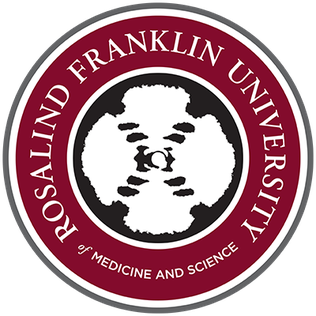Related Research Articles
A medical school is a tertiary educational institution, professional school, or forms a part of such an institution, that teaches medicine, and awards a professional degree for physicians. Such medical degrees include the Bachelor of Medicine, Bachelor of Surgery, Master of Medicine, Doctor of Medicine (MD), or Doctor of Osteopathic Medicine (DO). Many medical schools offer additional degrees, such as a Doctor of Philosophy (PhD), master's degree (MSc) or other post-secondary education.

Rosalind Franklin University of Medicine and Science (RFU) is a private graduate school in North Chicago, Illinois. It has more than 2,000 students in six schools: Chicago Medical School, College of Health Professions, College of Nursing, College of Pharmacy, Dr. William M. Scholl College of Podiatric Medicine, and School of Graduate and Postdoctoral Studies. The university is named for famous DNA crystallographer Rosalind Franklin. Photo 51, an X-ray diffraction pattern of the B form of DNA, captured by Franklin in 1952, was pivotal in 20th-century history of biology. The image is depicted in the university's seal and logo.
Pediatric nursing is part of the nursing profession, specifically revolving around the care of neonates and children up to adolescence. The word, pediatrics, comes from the Greek words 'paedia' (child) and 'iatrike' (physician). 'Paediatrics' is the British/Australian spelling, while 'pediatrics' is the American spelling.
Nurse education consists of the theoretical and practical training provided to nurses with the purpose to prepare them for their duties as nursing care professionals. This education is provided to student nurses by experienced nurses and other medical professionals who have qualified or experienced for educational tasks, traditionally in a type of professional school known as a nursing school of college of nursing. Most countries offer nurse education courses that can be relevant to general nursing or to specialized areas including mental health nursing, pediatric nursing, and post-operative nursing. Nurse education also provides post-qualification courses in specialist subjects within nursing.

Medical education is education related to the practice of being a medical practitioner, including the initial training to become a physician and additional training thereafter.

Aga Khan University is a not-for-profit institution and an agency of the Aga Khan Development Network. It was founded in 1983 as Pakistan's first private university. Starting in 2000, the university expanded to Kenya, Tanzania, Uganda, the United Kingdom and Afghanistan.
The term virtual patient is used to describe interactive computer simulations used in health care education to train students on clinical processes such as making diagnoses and therapeutic decisions. Virtual patients attempt to combine modern technologies and game-based learning to facilitate education, and complement real clinical training. Using virtual patients is increasing in healthcare due to increased demands on healthcare professionals, education of healthcare trainees, and providing learners with a safe practice environment. There are many formats from which a virtual patient may be chosen, but the overarching principle is that of interactivity. Virtual patients typically have mechanisms where information is parsed out in response to the learners, simulating how patients respond to different treatments. Interactivity can be created with questions, specific decision-making tasks, text composition, etc., and is non-sequential. Most systems provide quantitative and qualitative feedback. In some cases, virtual patients are not full simulations themselves, but are mainly based on paper-based cases; as they do not allow for physical examination or an in-depth medical history of an actual patient. There are certain drawbacks as crucial clinical findings may be missed due to the lack of examining patients in person.

Massachusetts College of Pharmacy and Health Sciences (MCPHS) is a private university focused on health- and life-sciences education, with campuses in Boston, Massachusetts, Worcester, Massachusetts, and Manchester, New Hampshire, as well as online programs. The university provides traditional and accelerated programs of study focused on professional education in pharmacy and the health sciences.
Modern medical education in Hong Kong started with the founding of the Hong Kong College of Medicine for Chinese in 1887. Currently, six institutes of higher education are engaged in the training of medical practitioners in Hong Kong.
The University of Virginia School of Nursing, established in 1901, is a school of nursing education. It has an enrollment of approximately 800 students, and is consistently rated in the top 4% of U.S. nursing schools. After the retirement of Dorrie K. Fontaine as the fifth dean of the School, two-term American Nurses Association President Pam Cipriano, a research faculty member at UVA for years, stepped in as interim dean in August 2019.

Georgetown UniversitySchool of Nursing is one of the eleven schools of Georgetown University. Founded in 1903 as the School of Nursing, it added three other health related majors in 1999 and appended its name to become the School of Nursing & Health Studies. In 2022, the school returned to the name School of Nursing, as the School of Health was divided from it. The school has been at the forefront of education in the health care field, offering many programs unique to America's elite institutions. Offering undergraduate and graduate programs in the health sciences, graduates are prepared to enter the complex fields of medicine, law, health policy, and nursing. The School of Nursing is made up of the Department of Health Systems Administration, the Department of Human Science, the Department of International Health, and the Department of Nursing.
The Florida State University College of Nursing, is the nursing school of the Florida State University. About 553 students are enrolled in classes, including undergraduates and graduate students. All programs are accredited by the Commission on Collegiate Nursing Education.
The University of San Francisco School of Nursing and Health Professions (SONHP) is the nursing school of the private University of San Francisco, located in San Francisco, California. First established in 1954, the school has approximately 1,300 students.

The University of Sheffield Medical School is a medical school based at the University of Sheffield in Sheffield, South Yorkshire, England. The school traces its history back to at least 1828. It operated independently until its merger with Firth College and Sheffield Technical School in 1897, and is now an integral part of Sheffield's Faculty of Medicine, Dentistry and Health.

The University of Florida College of Medicine – Jacksonville is the largest of the three University of Florida Health Science Center Jacksonville colleges — medicine, nursing and pharmacy. The college's 16 clinical science departments house more than 440 faculty members and 380 residents and fellows. The college offers 34 accredited graduate medical education programs and 10 non-standard programs.

Riga Stradiņš University (RSU) is a public university located in the city of Riga, Latvia. The name Stradiņš in the university's title refers to the Stradiņš family who have had a significant influence on the course of community and academic life in Latvia for over a century.
Rocky Mountain University of Health Professions (RMUoHP) is a private, for-profit university focused on graduate healthcare education and located in Provo, Utah. It was established in 1998 and is accredited by the Northwest Commission of Colleges and Universities.
Nursing in Japan did not develop as an occupation until the end of the nineteenth century. Initially introduced only in Tokyo in the late 1860s, small schools utilizing Western models were being opened by the late 1880s. In response to disaster relief, the Japanese Red Cross became an integral part of nursing development. By 1915, nurse registration had been established and public health nurses began working throughout the country. Nursing universities were established in the twentieth century and regulations were passed to develop standards for training and public health.

Government Medical College, Aurangabad is a medical school affiliated to the Maharashtra University of Health Sciences (MUHS), Nashik. The College is recognized by the Medical Council of India (MCI), New Delhi for medical education in India. It was founded in 1956. At present, the college accepts 200 students per year for the undergraduate course MBBS and around 127 students per year for the various postgraduate courses.
The University of Ghana Medical School also UGMS is the medical school of Ghana's first public research institution, the University of Ghana. It is currently located at the Korle Bu Teaching Hospital in Accra. The medical school was first planned in 1919, but took its first students in 1962.
References
- ↑ Alinier, Guillaume (2007). "Opening of an Enhancing Trainees' Learning Experiences through the Advanced Multiprofessional Simulation Training Facility at the University of Hertfordshire". British Journal of Anaesthetic and Recovery Nursing. 8 (2): 22. doi: 10.1017/S1742645607000125 . hdl: 2299/866 .
- ↑ Alinier, Guillaume; Hunt, Barry; Gordon, Ray; Harwood, Colin (2006). "Effectiveness of intermediate-fidelity simulation training technology in undergraduate nursing education". Journal of Advanced Nursing. 54 (3): 359–369. doi:10.1111/j.1365-2648.2006.03810.x. hdl: 2299/394 . PMID 16629920.
- ↑ Alinier, Guillaume; Hunt, William B.; Gordon, Ray (2004). "Determining the value of simulation in nurse education: Study design and initial results". Nurse Education in Practice. 4 (3): 200–207. doi:10.1016/S1471-5953(03)00066-0. hdl: 2299/392 . PMID 19038158.
- ↑ Alinier, Guillaume (2003). "Nursing students' and lecturers' perspectives of objective structured clinical examination incorporating simulation". Nurse Education Today. 23 (6): 419–426. doi:10.1016/S0260-6917(03)00044-3. hdl: 2299/393 . PMID 12900190.
- ↑ Alinier G, Sockalingam I. PRHOs pre/post perception of medical simulation training in their clinical practice. Abstract presented as a poster at the 2005 Annual Scientific Meeting of the Society in Europe for Simulation Applied to Medicine (SESAM), Bristol, UK, 19–21 May 2005
- ↑ Sockalingam I, Alinier G. Development and evaluation of acute care high fidelity simulation course for foundation trainees. Poster presented at the Annual Meeting of the Association for Medical Education in Europe, Tronheim, Norway, 25–29 August 2007
- ↑ Khan, Yasmeen (29 October 2008). "Simulation training day". BMJ. 337: cf_khay_simulationdipl. doi:10.1136/bmj.a1982. S2CID 80229595.
- ↑ Alinier G, Harwood C, Harwood P, Montague S, Huish E, Ruparelia K, 2009. Development of a programme to facilitate interprofessional simulation-based training for final year undergraduate healthcare students. The Higher Education Academy – Health Sciences and Practice Subject Centre
- ↑ http://www.health.herts.ac.uk/hicesc/courses/nams-csn2007.htm%5B%5D
- ↑ "SESAM 2008 Conference". Archived from the original on 7 August 2009. Retrieved 24 January 2010.
- ↑ "Welcome to the SESAM website :: SESAM - Society in Europe for Simulation applied to medicine".
- http://www.health.herts.ac.uk/hicesc/ Archived 28 June 2010 at the Wayback Machine
- Alinier G, 2008. La simulation comme projet d’excellence universitaire: l’exemple de l’Université de Hertfordshire en Angleterre. La Revue des SAMU – Médecine d’Urgence, Numéro Spécial Simulation, 30:349-354 ([ permanent dead link ])